Friends and I regularly travel to Norway to tap the spectacular sea angling now widely profiled in the angling media. Our destination this year was Koppangen, a two hour drive in a north easterly direction from Tromso, or alternatively 40 minutes on the Breivikeidet to Svensby ferry. A minibus and trailer met us at Tromso airport, and after loading the gear, it was off to the supermarket for provisions.
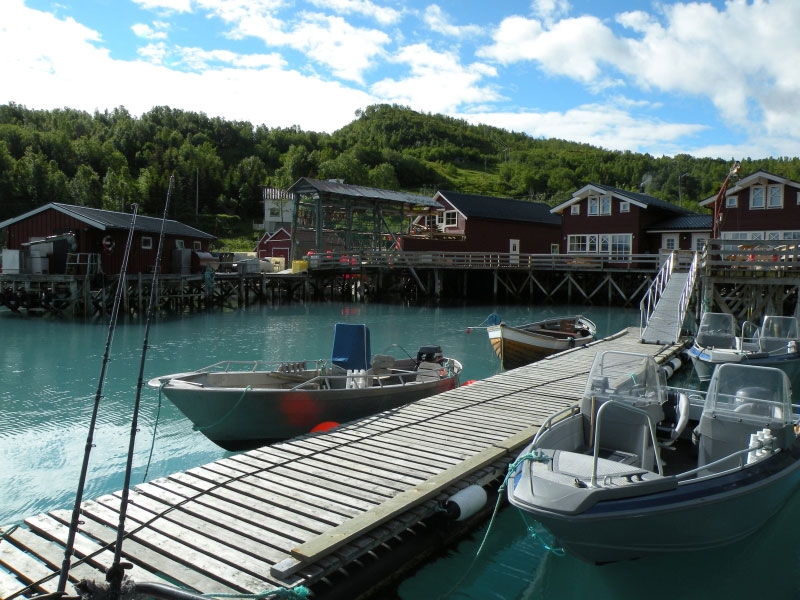
Cod obsessed British anglers travel to Norway primarily to catch big cod of proportions very seldom seen in home waters. The Norwegians are cod blessed, and as such the nation has no such fixation. There are plenty of other species to catch in Norway, particularly in the southern to mid regions where big coalfish, pollack, haddock, plaice and powerful halibut are caught. Further seasonal species diversity exists with mackerel, garfish, gurnards, flatfish, conger, hake, torsk, wolffish, ling, spurdog, and several unusual deep water species. Northern Norway seems to lack pollack, mackerel and gars, but big halibut exist here in greater numbers than was previously believed. Visiting anglers used to catch few halibut because fishing efforts focused firmly on cod.
Anglers are now actively targeting halibut, with fish to well over 100lb not uncommon. Talk to other anglers who have been to Norway and you realise everyone’s experiences are different. Anglers have their preferred destinations, techniques, and favourite species, but I have found that you do not need to pack masses of fishing gear to be successful. By all means take a few jiggers or pirks, but filling a box with them is an unnecessary and expensive burden.
No jiggery-pokery
We planned to fish for different species and not robotically bounce jiggers along the bottom for a week. I was determined to catch a halibut. We had booked a 30ft Norwegian-built boat similar to an Aquastar. It offered plenty of room for 6 anglers but wasn’t the fastest boat in the world. Koppangen and other fishing centres throughout Norway also operate smaller boats suitable for up to 4 anglers. These have 75hp outboards and are very fast. But based on previous experience choosing the 30ft diesel-engined job saved us fortunes in fuel. Koppangen fishing centre has two 30ft boats and four smaller alloy hulled boats.


We were lucky to find some big fish on our first day after just 20 minutes steaming. Water in the small bay was a milky turquoise due to glacial run off. Sprats would frequently be pushed to the surface by huge numbers of charging coalfish, attracting swathes of gulls and occasionally a majestic white-tailed sea eagle. The oddly coloured water didn’t put the fish off at all. Many of the cod we landed spewed sprats, and there was no end of similarly gorged coalfish to 5lb, with the biggest of 8lb falling to Chaz Walker. Brian Lee had a cod of 25lb plus, and Nigel Gemmell had a brace of solid 18 pounders.
Paul Lee was burst off by a monster, and numerous cod between 8lb and 18lb were landed. At one point I had three doubles in three drops, and there were regular occasions when everyone played doubles simultaneously. Chaz and Paul both had bonus small halibut around 5lb drifting close to the beach. Lyngenfjiord faces north and each day without fail a northerly sea breeze would pick up by midday providing a better drift. Fishing deeper brought coalfish, smaller cod and redfish. Tidal push was minimal in the fjiord, and any boat movement was wind driven. 5 – 8oz leads were more than adequate, and snags turned out to be few. The midnight sun always takes some getting used to. After tidying the gear, a shower, and dinner it was indeed midnight, though it seemed more like 4pm.
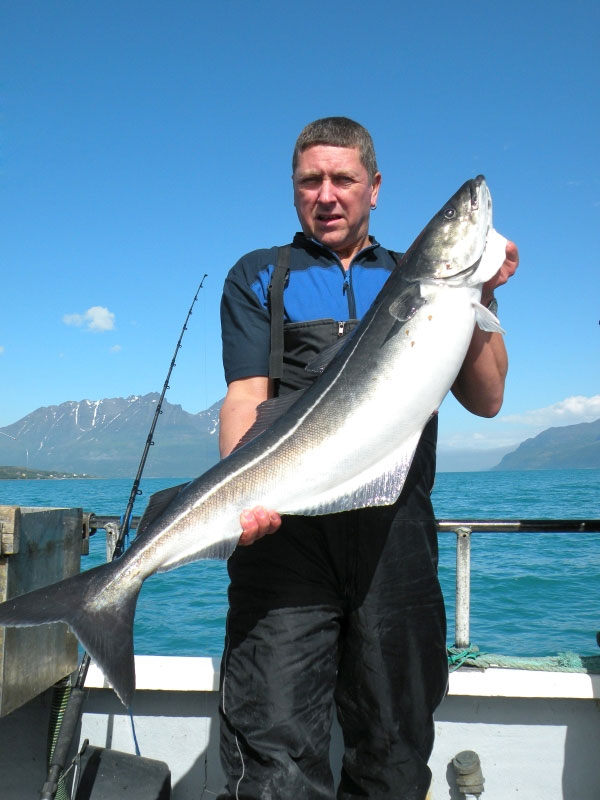
East of Koppangen
The next day marks behind some islands to the East of Koppangen gave only smaller coalfish, torsk, and ling. A 160 metre mark in the middle of Lyngen gave Brian two good redfish, before we finished up back at the Bay on the flood tide, repeating the previous day’s success. But there were no fish over 20lb this time. The best fishing was on the flood, but the locals said fish can turn up at any time, with August best time for big summer cod, and November best for halibut. There was a commercial boat working nets based at Koppangen and we interrogated the skipper for pointers as he was landing one morning. He invited us aboard and provided precise mark co-ordinates for big cod… and superb information this later proved to be.
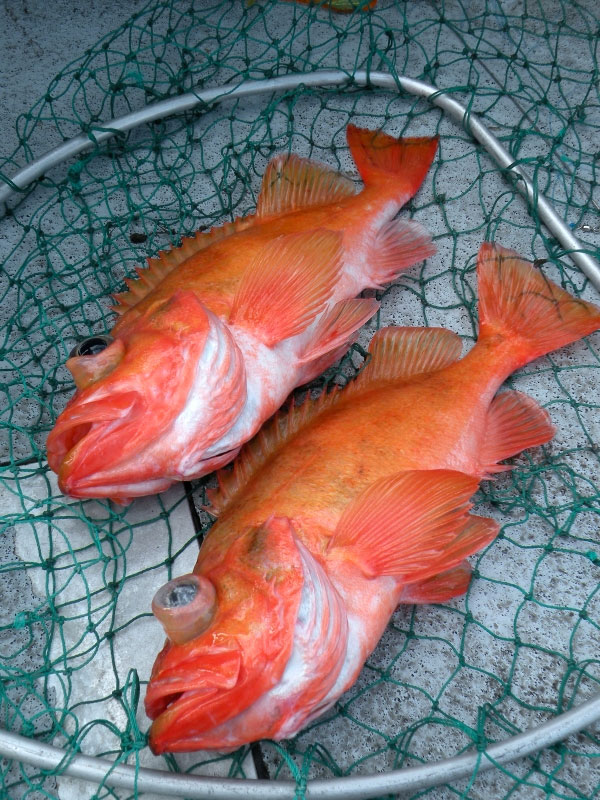
Saturday was sweltering hot. We steamed for two hours to Rotsund with Nigel at the wheel. Temperatures hit the mid seventies by early afternoon, and all of us suffered nasty sunburn by the end of the day. The rarified atmosphere this far north allows more of the suns UV rays to get through, and sensible people take more care! We arrived an hour before low water in advance of the flood tide. Our early pickings in the shelter of Uloya island were some torsk, wolfish, and small cod, but the flood brought spectacular fishing, if only for a few hectic hours. The deeper water also provided little, so we headed inshore to work drifts from 60 to 20 metres. Repeated drifts earned us masses of cod to 10lb, good numbers of 10 – 16lb fish, a few over the 20lb. We also enjoyed cracking sport with coalfish over 10lb.
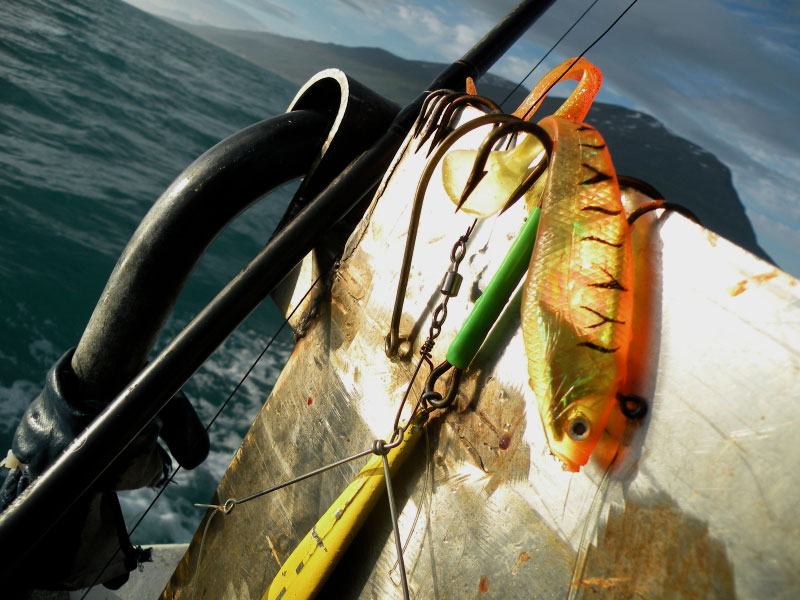
Nigel was the first to hit a bigger fish on his £300 Shimano Fireblood specimen rod and XTA 5000 fixed spool reel loaded with 30lb braid. A 20lb 8oz cod was finally landed after several pummelling dives. I managed another hat trick of doubles in as many drops – biggest was just under 17lb. Brian landed a 25lb cod, before we suddenly had to contend with a spell of big coalfish hammering our lures right on the surface. Whether they were actually surface feeding or following from depth and striking out at the last is a mystery. Hooked fish were ejecting sprats on the surface. Jason was the first to connect with a supercharged coalfish, which he dually lost as it towed straight down against a carelessly tight drag. With the drag notched back, he hit another straight away that eventually scaled 20lb 2oz.
Brian was clobbered next by a huge fish; his buckled frame powerless to resist as the sporty three-piece Shimano12lb/20lb rod bent double, braid tearing from the ABU 6000 reel. Time and again he won back line only for the brute to pull away again. Eventually, after many torturous minutes, a huge black-bodied coalfish surfaced. It was too big for the net. I somehow managed to grapple it awkwardly into the boat. The fantastic fish forced protesting scales round to 29lb 15oz.
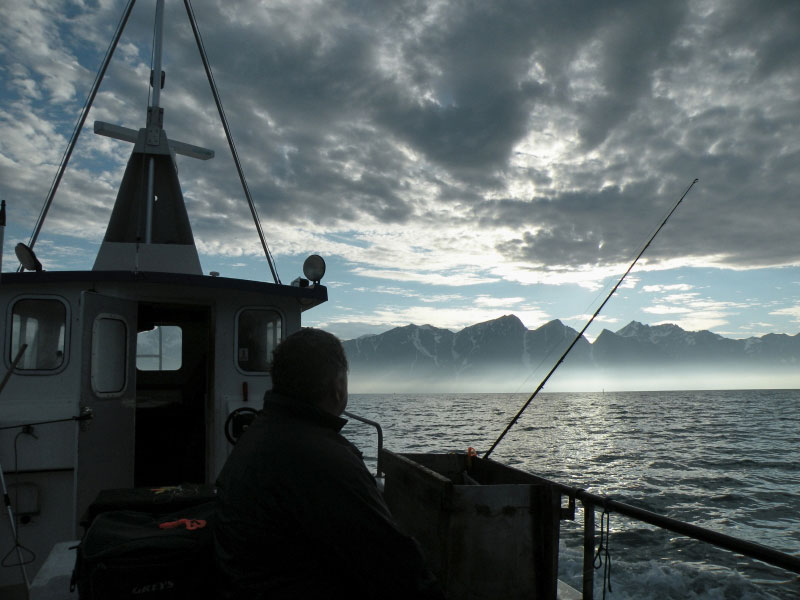
In a spin
I was now fishing with my spinning rod and 8lb line. A fish took my lure close to the surface and sped for the bottom. I could do nothing except apply as much steady pressure as I dared. Every time I managed to pump a little line back, the fish contemptuously pulled away and circled the boat. After skilfully de-weaving Nigel’s snaring braid everyone stopped fishing. I was in a real battle. The rod constantly nod-nodded as the fish stayed deep. A sudden roasting run stripped line. To-ing and fro-ing, I’d grind back inches then helplessly surrender it again. This draining cyclic madness lasted an imagined eternity.

After what seemed hours the fight appeared to go out of the fish, but just as I was beginning to harbour thoughts of an end, it dropped a gear and headed for hell again! Could be a halibut? Always gingerly, I ushered it back to mid-water several times more, only for it to groundhog me and U-turn south again. Twenty minutes had elapsed and the fish was nowhere in sight. Each run sapped strength from both of us, but I was the stronger. I sensed and felt the lunging ferocity waning. ‘Relief’ doesn’t adequately describe how I felt when the leader knot and then fish finally appeared some 40 minutes after first contact. It was a big jet-flanked coalfish rather than a halibut, its dark saucer eye radiating defiance. The net could accommodate this one and Jason did the honours with a fish that went 22lb 2oz.

Chicken halibut
The cod where back with a real vengeance. Nigel returned a bucket-mouth 25 pounder, while I suffered another 10lb coalfish on the spinning rod that had me close to tears. My back, arms, neck and jaw muscles were killing me. I went back to the proper boat rod for a bit of respite. Again a fish hit my lure just beneath the surface and ran straight for the bottom. This one fought differently, diving down at staggered intervals while projecting a feeling of dead weight between times. A halibut topped. But just as Brian reached for the net it tore back down at unbelievable speed, leaving a trail of bubbles in its wake. Luckily, I had slackened the drag off as fish broke the surface. The remaining fight was short-lived, and a chicken halibut was soon in the net, photographed and released. This modest 7lb 8oz fish easily put cod three times the size to shame in the muscle department. And goodness knows how you land the 200lb plus monsters that are undoubtedly here.

A bank of fog closed in and the temperature quickly plummeted. Heading home, we estimated a haul of 140 good fish, nearly all of which were set free. We returned the following day but fish had moved on and we failed to repeat the magic. Monday took us to Olderdalen on the east side, where we’d heard cod to 30lb had been landed the previous week. The day was cold, the sea choppy, and the fishing rotten. My miserable return was a single haddock, a cod, and a torsk. We persevered at several different locations before returning to the little bay fished on the first day. Sprats were boiling on the surface but we caught only a few coalfish. Tuesday was our last day. We made an early start, heading for as yet untried marks given to us by our commercial fisherman friend. We pushed out to the furthest ground at Arnoya at the mouth of Lyngenfjiord, and would work back to base. A hot sun and calm conditions made for a pleasurable journey, and we marvelled at an enormous sprat shoal that stretched unbroken for almost three miles.
Little and large
The first few spots produced little. We moved to Hamnes, an area known for halibut. Sprats spattered the surface and we dropped straight into cod and torsk to 8lb. Having just lost a big fish, Jason went straight back down and landed a 27lb ‘elephant’ – the biggest cod of the trip. Slowly retrieved lures brought multiple takes, while Brian succumbed to jigging weakness and dually banged out a 25lb cod. A crazy hour brought lots of teen doubles and five cod over 20lb.

A fish hammered into Charlie’s lure right under the surface and tore off like a train – a sure-fire halibut. Charlie could do nothing other than hang on for ten killer minutes as the fish hugged the bottom. A familiar man verses monster tug of war ensued, before the dark profile of a halibut came into view. It went 17lb that one. More cod followed, before everything suddenly stopped – no more takes at all. Back at Koppangen, we cleaned the fish we had kept. We had paid an excess baggage allowance which allowed us to take 20kg of frozen fish fillets back. The Koppangen fishery kindly supplied polystyrene boxes and packing bags. Previous trips had seen us pay £10 each for these boxes.
Hindsight
Hard fighting Koppangen fish are beautiful golden spotted specimens. They often feed high in the water table, chasing highly nutritional prey rather than sulking about the bottom sucking up the dregs like the cod we are more accustomed to. It is noticeable that even when brought up from depth these cod will go straight back down head first to the bottom… few North Sea cod will do that. Because the fish are active at different depths you have to think outside the box when pursuing them. The curse of hindsight suggests we should have fished an all-night session (it is still light remember), as this is when the sea is calmest and fish congregate in the upper layers chasing baitfish. We were advised to do exactly this by the locals but just never got round to it. Next trip we will.
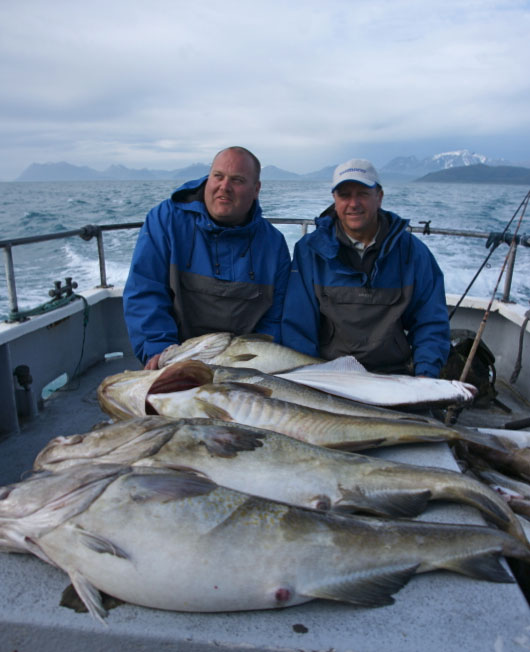
Lures & leads
The majority of our fish where taken on lures fished on long flowing traces. Only Brian Lee who chose to fish pirks on the last day could report otherwise. Strange as it is, I have never used big lumps of metal in Norway. I pack a selection of Red Gills, jellyworms, Sidewinders, shads and mackerel spinners, and fish light. I carry only six 5 – 8oz leads and a few 1oz leads. When cast uptide on a spinning rod, the 1 – 2oz mackerel spinners are amazingly effective, but be sure to fit a bigger treble or a strong single hook.
Rods & reels
I pair a Ron Thompson Carboflex 30lb class boat rod with an ABU 7000 reel loaded with 18lb mono and a 35lb leader. I do not use braid as I prefer the cushioning properties of mono. I lost few fish over the week, while others using braid regularly dropped fish. An ABU 12 reel is carried for deeper water fishing, but it is rarely used as nearly all fish are found in 30 – 80 metres.
Light tackle sport
I light to push light tackle to the sporting maximum. In the extreme, I caught double-figure cod and a coalfish of 22lb 2oz on 8lb line and an old classic ABU 403 spinning rod. There is no problem landing big or even huge fish if your tackle is correctly balanced and you are not in any hurry. Don’t be afraid to let powerful fish run, exercise, enjoy the thrill of the fight and take your time in playing them in. Remember, even a 40lb cod weighs hardly anything when it is in the water.
Fish location & tactics
Even in water of considerable depth fish are often found in the upper layers. The technique of slowly retrieving a shad on a long trace out-fished everything else. Quite often a fish would have several jabs at a lure before finally taking it close to the surface. The key is to resist striking; keep reeling. I hooked several fish when my leader knot out of the water. These fish fight hard crash-diving back to the depths, so the reel drag must be correctly set.

















